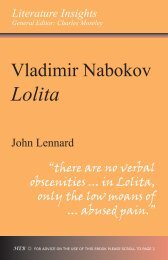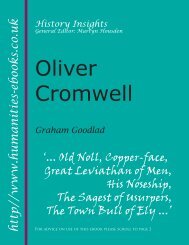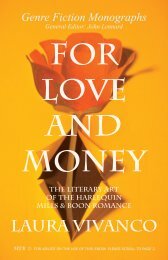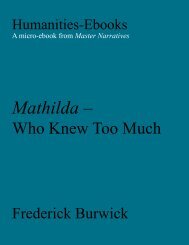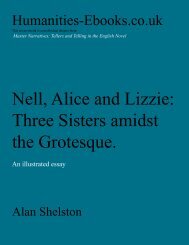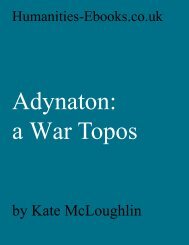by John Lennard - Humanities-Ebooks
by John Lennard - Humanities-Ebooks
by John Lennard - Humanities-Ebooks
You also want an ePaper? Increase the reach of your titles
YUMPU automatically turns print PDFs into web optimized ePapers that Google loves.
8<br />
Introduction<br />
“a cloud shaped like his island home”<br />
Like its author, View from Mount Diablo is powerfully hybrid—a verse-novel that<br />
won the Jamaican National Literary Award in manuscript in 2001, and was<br />
published in the UK <strong>by</strong> Peepal Tree Press in 2003. Ralph Thompson (b.1928) is a<br />
white Jamaican, of crypto-Jewish and Irish stock, who received a Jesuit education.<br />
Through his absent father’s US nationality he was eligible for military service, and<br />
after graduating in law from Fordham University in 1950 spent two years as a USAF<br />
officer in Japan, but he is married to a Jamaican and has lived in Kingston save for a<br />
brief period in the 1970s when political violence forced the family overseas.<br />
Thompson’s career was largely in business, with Seprod Ltd (a large firm supplying<br />
household commodities and consumer products, for whom he was a long-serving,<br />
highly successful CEO), but included educational activism with extensive<br />
journalism, exhibitions of paintings, and latterly two well-received poetry<br />
collections—The Denting of a Wave (1992) and Moving On (1997) 01 —before<br />
expanding with View from Mount Diablo to embrace the verse-novel. Itself<br />
intrinsically hybrid, that form is stretched <strong>by</strong> the generic models for Thompson’s<br />
plot, the Bildungsroman and the crime novel, and additionally distorted <strong>by</strong> wideangle<br />
narration bending an account of Jamaican social and political history from the<br />
1930s–2000s into one truncated and foreshortened fictional life.<br />
The protagonist, reporter and family-man Adam Cole, remembers the war-years<br />
of the 1940s, and cannot be much younger than Thompson himself—born sometime<br />
in 1930–5. He married after graduating from university, c.1955, and <strong>by</strong> chapter 6 has<br />
a daughter of 15, making it the early 1970s. The violent, tragic events that dominate<br />
chapters 6–12 thus seem at first to invite mapping onto the ‘Manley Years’ (1972–<br />
80), and the final killings might be thought specifically to summon the later 1970s, a<br />
very bloody time in Jamaica—but the ‘Manley Years’, however neat a tag, marked<br />
an escalation as much as an inception, and all later events in the verse-novel<br />
subsume continuing, generically similar events of the 1980s–2000s. The particular<br />
role of the cocaine trade in the dénouement also points to a more recent date than the<br />
1970s, and it is clear the Jamaican history Thompson presents, if profoundly verisimilar,<br />
is as much an archetypal assemblage of chronic political and psychological<br />
1<br />
Both are published <strong>by</strong> Peepal Tree Press.









